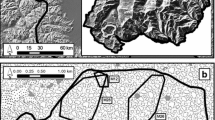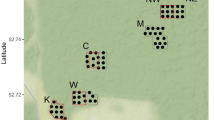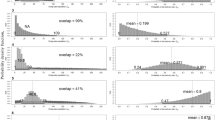Abstract
A design-based strategy for estimating wildlife ungulate abundance in a Mediterranean protected area (Maremma Regional Park) is considered. The estimation is based on pellet group count (clearance count technique) in a set of plots, whose size and number is established on the basis of practical considerations and available resources. The sampling scheme involves a preliminary stratification and subsequent two-stage sampling. In the first stage, large strata (defined through habitat features) are partitioned into spatial units and a sample of units is selected by means of a sampling scheme ensuring inclusion probabilities proportional to unit size, but avoiding the selection of contiguous units. Then, the abundances of the selected units are estimated in a second stage, in which plots are located using a random scheme ensuring an even coverage of the units. In small strata, only the second stage is performed. Unbiased estimators of abundance and conservative estimators of their variances are derived for each strata and for the whole study area. The proposed strategy has been applied since the Summer of 2006 and the estimation results reveal substantial improvement with respect to the previous results obtained by means of an alternative strategy.
Similar content being viewed by others
References
Aubry P, Debouzie D (2000) Geostatistical estimation of variance for the spatial mean in two-dimensional systematic sampling. Ecology 81: 543–553
Barabesi L, Fattorini L, Ridolfi G (1997) Two-phase surveys of elusive populations. In: Proceedings of the statistics Canada symposium 97: new directions in surveys and censuses. Statistics Canada, Ottawa, pp 285–287
Bennet G (1962) Probability inequalities for the sum of independent random variables. J Am Stat Assoc 57: 33–45
Börger L, Franconi N, Ferretti F, Meschi F, De Michele G, Gantz A, Coulson T (2006) An integrated approach to identify spatiotemporal and individual-level determinants of animal home range size. Am Nat 168: 471–485
Brewer KRW, Hanif M (1983) Sampling with unequal probabilities. Springer, New York
Bryant D, Chang Y, Rodger CA, Wei R (2002) Two-dimensional balanced sampling plans excluding contiguous units. Commun Stat Theory Methods 31: 1441–1455
Campbell D, Swanson GM, Sales J (2004) Comparing the precision and cost-effectiveness of faecal pellet group count methods. J Appl Ecol 41: 1185–1196
D’Orazio M (2003) Estimating the variance of the sample mean in two-dimensional systematic sampling. J Agric Biol Environ Stat 8: 280–295
Fattorini L (2006) Applying the Horvitz-Thompson criterion in complex designs: a computer-intensive perspective for estimating inclusion probabilities. Biometrika 93: 269–278
Fattorini L (2009) An adaptive algorithm for estimating inclusion probabilities and performing Horvitz-Thompson criterion in complex designs. Comput Stat 24: 623–639
Fattorini L, Ridolfi G (1997) A sampling design for areal units based on spatial variability. Metron 55: 59–72
Fattorini L, Pisani C (2004) Variance decomposition in two-stage plot sampling: theoretical and empirical results. Environ Ecol Stat 11: 385–396
Fattorini L, Pisani C, Sforzi A (2004) The estimation of wildlife ungulate abundance using sample area surveys: an application to Maremma Regional Park. Stat Method Appl 13: 197–212
Gerard JF, Loisel P (1995) Spontaneous emergence of a relationship between habitat openness and mean group size and its possible evolutionary consequences in large herbivores. J Theor Biol 176: 511–522
Lahiri DB (1951) A method of sample selection providing unbiased ratio estimates. Bull Int Stat Inst 33: 133–140
Lorenzini R, Lovari S, Masseti M (2003) The rediscovery of the Italian roe deer: genetic differentiation and management implications. Ital J Zool 69: 367–379
Lovari S, Bartolommei P, Meschi F, Pezzo F (2008) Going out to mate: excursion behaviour of female roe deer. Ethology 114: 886–896
Massei G, Bacon P, Genov P (1998) Fallow deer and wild boar pellet group disappearance in a Mediterranean area. J Wildl Manage 62: 1086–1094
Massei G, Genov P (1998) Fallow deer (Dama dama) winter defecation rate in a Mediterranean area. J Zool Lond 245: 209–210
Mayle BA, Peace AJ, Gill RMA (1999) How many deer? A field guide to estimating deer population size. Forestry Commission Field Book n. 18, Edinburgh
Midzuno H (1952) On the sampling system with probability proportional to sum of sizes. Ann Inst Math Stat 3: 99–107
Mitchell B, Rowe JJ, Ratcliffe PRR, Hinge M (1985) Defecation frequency in roe deer (Capreolus capreolus) in relation to the accumulation rates of faecal deposits. J Zool (London) 207: 1–7
Neff DJ (1968) The pellet group count technique for big game trend, census, and distribution: a review. J Wildl Manage 32: 597–614
Overton WS (1971) Estimating the number of animals in wildlife populations. In: Giles RH (eds) Wildlife management techniques. The Wildlife Society, Washington, pp 403–455
Putman RJ (1996) Ungulates in temperate forest ecosystems: perspectives and recommendations for future research. For Ecol Manage 88: 205–214
Ratcliffe PR, Mayle BA (1992) Roe deer biology and management. Forestry Commission Bullettin n. 105, London
Rogers LL (1987) Seasonal changes in defecation rates of free-ranging white-tailed deer. J Wild Manage 51: 330–333
Scott A, Wu C (1981) On the asymptotic distribution of ratio and regression estimators. J Am Stat Assoc 76: 98–102
Skalski JR (1994) Estimating wildlife population based on incomplete area surveys. Wildl Soc Bull 22: 192–203
Stevens DL, Olsen AR (1999) Spatially restricted surveys over time for aquatic resources. J Agric Biol Environ Stat 4: 415–428
Stevens DL, Olsen AR (2003) Variance estimation for spatially balanced samples of environmental resources. Environmetrics 14: 593–610
Stevens DL, Olsen AR (2004) Spatially balanced sampling of natural resources. J Am Stat Assoc 99: 262–278
Sutherland WJ (1996) The twenty commonest censusing sins. In: Sutherland WJ (eds) Ecological census techniques. Cambridge University Press, Cambridge (UK), pp 317–318
Thompson SK (2002) Sampling. Wiley, New York
Wolter KM (1985) Introduction to variance estimation. Springer, New York
Wywial J (1996) On space sampling. Stat Trans 2: 1185–1191
Author information
Authors and Affiliations
Corresponding author
Rights and permissions
About this article
Cite this article
Fattorini, L., Ferretti, F., Pisani, C. et al. Two-stage estimation of ungulate abundance in Mediterranean areas using pellet group count. Environ Ecol Stat 18, 291–314 (2011). https://doi.org/10.1007/s10651-010-0133-0
Received:
Revised:
Published:
Issue Date:
DOI: https://doi.org/10.1007/s10651-010-0133-0




